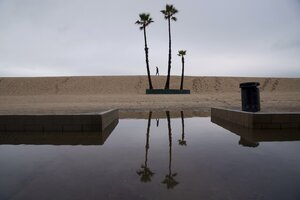What is a ‘bomb cyclone,’ and how hard will it hit the West Coast?
Local officials across the West Coast are bracing for flash floods, power outages, and possible blizzards at high altitudes after announcing heavy rain from Nov. 19 to Nov. 22. Powerful winds also raise concerns about the increased risk of wildfires.

A person walks along the beach with flooding along the boardwalk, Feb. 1, 2024 in Seal Beach, California. Heavy winds and rains are expected to hit the West Coast this week.
Eric Thayer/AP/File
Seattle
Northern California and the Pacific Northwest are bracing for what is expected to be a powerful storm, with heavy rain and winds set to pummel the region and potentially cause power outages and flash floods.
The Weather Prediction Center issued excessive rainfall risks beginning Nov. 19 and lasting through Nov. 22 as the strongest atmospheric river – long plumes of moisture stretching far over the Pacific Ocean – that California and the Pacific Northwest has seen this season bears down on the region. The storm system has intensified so quickly that it is considered a “bomb cyclone,” explained Richard Bann, a meteorologist with the National Weather Service Weather Prediction Center.
The areas that could see particularly severe rainfall as the large plume of moisture heads toward land will likely stretch from the south of Portland, Oregon, to the north of the San Francisco area, he explained.
“Be aware of the risk of flash flooding at lower elevations and winter storms at higher elevations. This is going to be an impactful event,” he said.
In northern California, flood and high wind watches go into effect Nov. 19, with up to 8 inches of rain predicted for parts of the San Francisco Bay Area, North Coast, and Sacramento Valley.
A winter storm watch was issued for the northern Sierra Nevada above 3,500 feet, where 15 inches of snow was possible over two days. Wind gusts could top 75 mph in mountain areas, forecasters said.
“Numerous flash floods, hazardous travel, power outages, and tree damage can be expected as the storm reaches max intensity” on Nov. 20, the Weather Prediction Center warned.
Meanwhile, Southern California this week will see dry conditions amid gusty Santa Ana winds that could raise the risk of wildfires in areas where crews are still mopping up a major blaze that destroyed 240 structures. The Mountain Fire, which erupted Nov. 6 in Ventura County northwest of Los Angeles, was about 98% contained on Nov. 18.
Winds will calm by the end of the week, when rain is possible for the greater Los Angeles area.
In southwestern Oregon near the coast, 4 to 7 inches of rain is predicted – with as much as 10 inches possible in some areas – through late Nov. 21 and early Nov. 22, Mr. Bann said,
A high wind warning has been issued for the north and central Oregon coast beginning at 4 p.m. Nov. 19 with south winds from 25 mph to 40 mph, with gusts to 60 mph expected, according to the weather service in Portland. Gusts up to 70 mph are possible on beaches and headlands. Widespread power outages are expected with winds capable of bringing down trees and power lines, the weather service said. Travel is also expected to be difficult.
Washington could also see strong rainfall, but likely not as bad as Oregon and California. From Nov. 18 evening through Nov. 19, some of its coastal ranges could get as much as 1.5 inches of rain, Mr. Bann said.
The weather service warned of high winds from Nov. 19 afternoon until early Nov. 20 for coastal parts of Pacific County, in southwest Washington. With gusts potentially topping 35 mph – and likely faster near beaches and headlands – trees and power lines are at risk of being knocked down, the Pacific County Emergency Management Agency warned.
Washington State Patrol Trooper John Dattilo, a patrol spokesperson based in Tacoma, posted on social media Nov. 18 afternoon that people should be prepared for “some bad weather” on Nov. 19. “Stay off the roads if you can!”
A blizzard warning was issued for the majority of the Cascades in Washington, including Mount Rainier National Park, starting Nov. 19 afternoon, with up to a foot of snow and wind gusts up to 60 mph, according to the weather service in Seattle. Travel across passes could be difficult if not impossible.
Outside of this region, the central and eastern Gulf Coast, including the Florida Panhandle, is at risk for flooding on Nov. 19, with 2 to 3 inches of rainfall in the forecast, according to the weather service. Low-lying and urban regions could see flash floods.
This story was reported by The Associated Press. AP writer Lisa Baumann contributed to this report.

